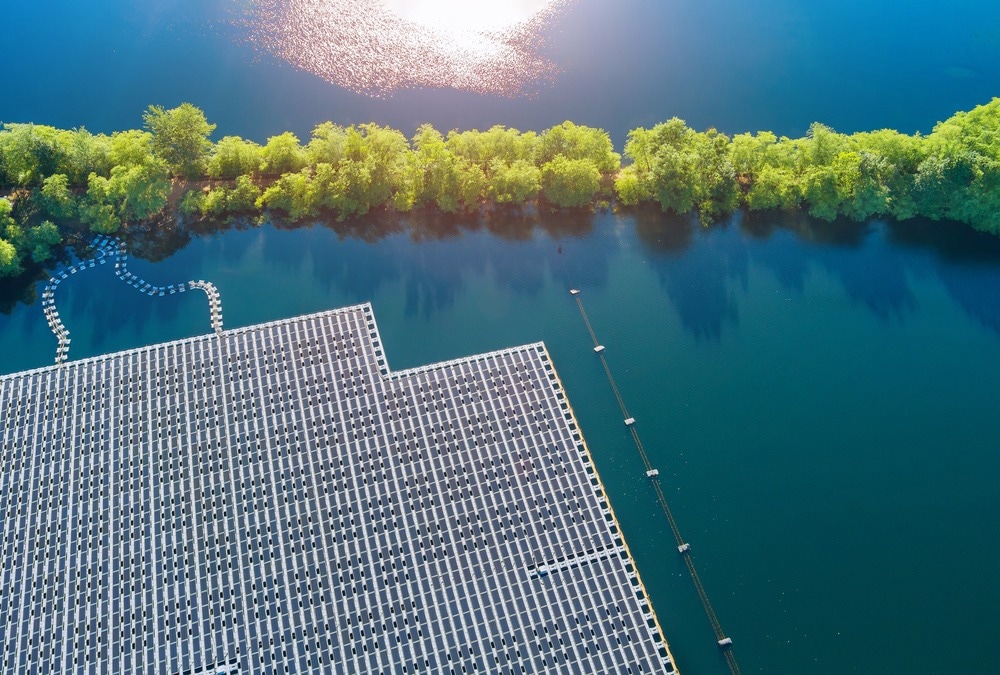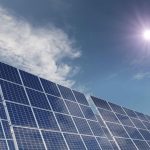In a recent article in Nature Water, researchers explored the global potential of floating solar photovoltaics (FPVs), a renewable energy technology that involves installing solar panels on water surfaces. They aimed to estimate the power output, water savings, and environmental benefits of FPVs across water bodies worldwide. This technology could play an important role in decarbonizing national economies and reducing water scarcity.
Image Credit: ungvar/Shutterstock.com
Background
PVs are among the fastest-growing and most cost-effective renewable energy sources, potentially meeting a significant fraction of global electricity demand. However, due to high temperatures, conventional PVs face challenges such as land-use competition, water consumption, and efficiency losses.
FPVs, which are PV systems mounted on floating structures on water bodies, can overcome some of these limitations by utilizing available water surface area, reducing evaporation, and benefiting from the cooling effect of water. They also offer advantages over land-based PVs in terms of installation, maintenance, and operation costs, as well as social acceptance and environmental impacts.
About the Research
In this paper, the authors aimed to quantify the energy generation potential of FPVs on over one million water bodies worldwide, including natural and artificial lakes and reservoirs larger than 0.1 square kilometers. They assessed the contribution of FPVs to energy system decarbonization and water resource management.
Data from the global solar energy estimator (GSEE) tool and climate input data from the global climate reanalysis were utilized. The study reconstructed the monthly water surface area time series for each water body from 1991 to 2020 to determine the theoretical power output of FPVs.
The researchers applied several criteria to select suitable water bodies for FPV deployment, such as proximity to population centers, protection status, ice cover duration, and water level fluctuations. They compared the FPV potential with each country’s electricity demand, carbon intensity, and electricity access, and calculated the water savings and CO2 emissions reduction achievable by FPVs. Moreover, they discussed the possible impacts of FPVs on water quality, algal blooms, and freshwater ecosystems.
Key methodologies included calculating the annual power output of a 1 kW FPV system and extrapolating these results to estimate the total global potential. Constraints such as proximity to population centers, protection status, ice cover duration, and water body permanence were considered to identify feasible sites for FPV deployment.
The water savings potential of FPVs was evaluated by assessing the reduction in evaporation losses due to the coverage of water surfaces by solar panels. The objective of this study was to provide a realistic assessment of FPVs’ capability to meet national electricity demands, reduce water scarcity, and contribute to decarbonization efforts.
Research Findings
The outcomes underscored the substantial potential of FPVs in renewable energy generation and water conservation. The theoretical global annual power output from FPVs, assuming 10% coverage of water bodies, was estimated at 14,906 TWh. This capacity could meet an average of 16% of the electricity demand for many countries, with some nations capable of fulfilling their needs through FPVs. Geographical variations were notable, with regions of higher solar irradiance, such as the western United States, the Andean Mountains, and the Qinghai-Tibet Plateau, exhibiting greater outputs.
Seasonal patterns in capacity factors were evident, with significant fluctuations between summer and winter in the Northern Hemisphere.
Larger water bodies naturally accommodate larger FPV arrays, producing higher power outputs. Despite constraints limiting suitable water bodies to 67,893, they could still generate a substantial 1302 TWh annually. Countries like China, Brazil, and the United States possess high FPV potential due to their extensive water bodies and significant electricity demand.
Regarding water conservation, FPVs offer significant potential to reduce evaporation from water bodies, particularly benefiting regions facing water scarcity. The shading effect of solar panels lowers water surface temperatures, resulting in reduced evaporation rates. This advantage is vital for arid and semi-arid regions with limited water resources. For instance, FPVs could meet 129% of Ethiopia’s electricity demand, 73% of Chad’s, 45% of Argentina’s, and 29% of Malawi’s. The study also estimated that FPVs could annually reduce global CO2 emissions by 0.45 billion tons and save 62.9 km³ of water through evaporation reduction.
Applications
The integration of FPVs has potential implications for various sectors and regions. These systems can enhance the performance and reliability of existing hydropower plants by sharing infrastructure and balancing the seasonal variability of water availability. Furthermore, they offer opportunities to improve water quality and ecosystem health in water bodies.
By mitigating algal blooms, reducing nutrient concentrations, and preventing thermal stratification, FPVs contribute to overall environmental sustainability and ecosystem resilience.
Conclusion
The authors emphasized the significance of FPVs within the global energy landscape. This technology could substantially contribute to renewable energy generation, water conservation, and decarbonization objectives. Future work should focus on tackling technical hurdles, engaging with stakeholders, refining designs, establishing a resilient regulatory framework, and investigating the socio-economic ramifications of widespread FPV implementation.
Woolway, R.I., Zhao, G., Rocha, S.M.G. et al. Decarbonization potential of floating solar photovoltaics on lakes worldwide. Nat Water (2024). https://doi.org/10.1038/s44221-024-00251-4
This post was originally published on 3rd party site mentioned in the title of this site





